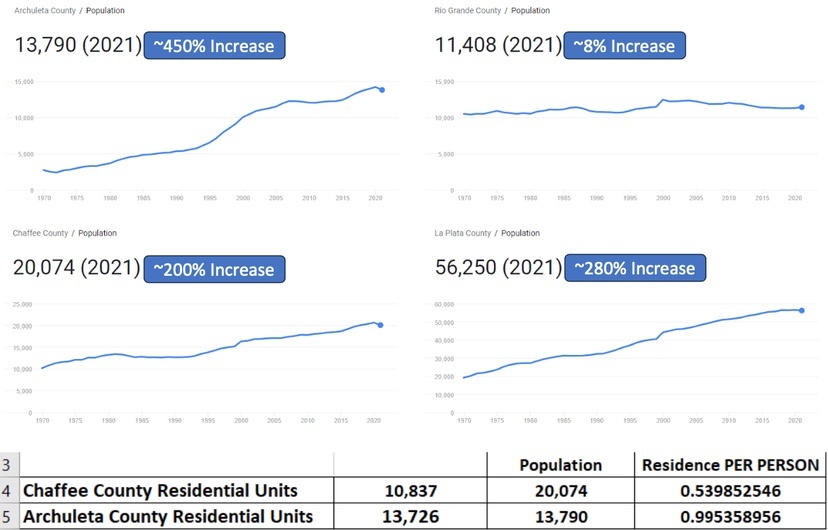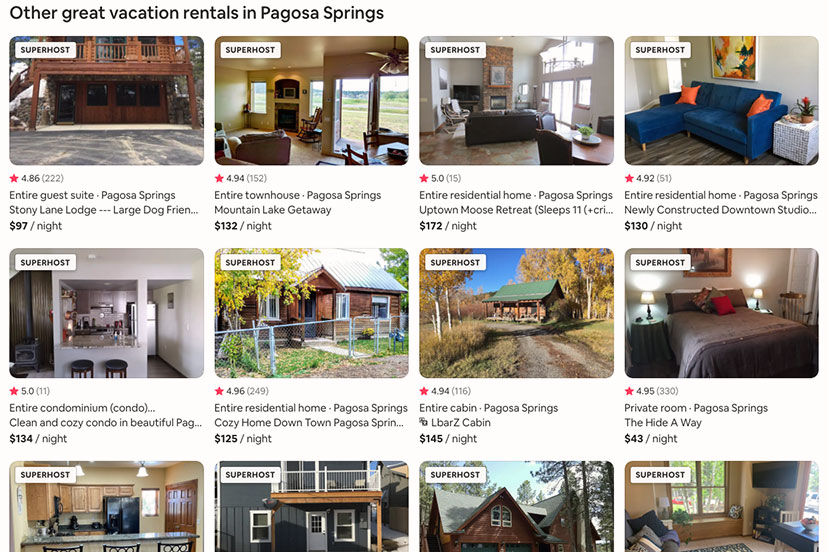In 2022, shortly after the Archuleta Board of County Commissioners (BOCC) authorized a Task Force to meet behind closed doors to develop policy recommendations for addressing the negative effects of the STR industry, I helped organize an ad hoc citizens study group, to answer essentially the same questions:
What are the negative effects of the STR industry on full-time residents, within the unincorporated county?
Can the negative effects be mitigated?
Unlike the County’s Task Force, our citizens group met publicly at the Sisson Library. The press was invited to observe. Our group was not dominated by industry representatives, although a few industry advocates did participate. It was, in other words, the type of study group the County could have constituted, if they had been interested in the opinions of ordinary taxpayers.
The composition of our citizens study group:

During the months while these meetings were being held by the Task Force and by our ad hoc group, the BOCC maintained a moratorium on new STR permits, as they waited to receive policy recommendations.
Following a series of public meetings, our citizens group presented our policy recommendations to the BOCC. As far as I know, none of our recommendations have been adopted.
Following a series of closed-door meetings, the County Task Force delivered its policy recommendations to the BOCC. I believe the only Task Force recommendation officially adopted by the BOCC was the suggestion to end the moratorium on new permits, and allow the STR industry to grow unchecked.
With that in mind, I was curious about a presentation planned for February 22, when the Archuleta County Planning Department would be sharing its latest ideas about the negative effects generated by our local STR industry, and what the BOCC might do about them. The ideas were shared with the County Planning Commission, presumably with the intention that the Commission would — someday soon — deliver policy recommendations to the BOCC.
The presentation was handled by Justin Griffin, Planner with the Archuleta County Planning Department. He shared a 12-page PowerPoint document discussing “cap rates” and “density distribution” with the Planning Commission.
Mr. Griffin:
“If the commissioners remember at our January 24 meeting… one attendee abruptly interjected and asked that the commissioners put caps on Short-Term Rentals (STRs). And everyone was kind of taken aback; no one was prepared to make a motion like that. So then it was discussed that the Planning Department would look at surrounding towns and counties to see what similar towns and counties have done in terms of cap rates and density distribution.
“So today, we’re not proposing any motion; we’re just bringing some attention [to the issue] because the attendee asked us to look into it.
“So let’s look into it and see where we are, versus other places. What challenges we face that are unique, or that are similar, and what policies we might want to move forward in the future.
“The first slide shows that we compared Pagosa Springs and Archuelta County to South Fork and Rio Grand County… Buena Vista, Poncha Springs and Salida in Chaffee County — which most of our planning staff feels is the best comparison, Buena Vista and Salida in particular… and Durango and Bayfield in La Plata County.”

“So going down the list of municipalities — Salida, Buena Vista, Durango, South Fork, Del Norte, Bayfield — all have Short-Term Rental cap rates. So does the Town of Pagosa Springs. Some of the regulations are complex; some are straightforward.”
As I mentioned in Part One, the Town of Pagosa Springs put cap rates and density distribution rules in place prior to the COVID crisis. But those regulations do not apply to unincorporated Archuleta County. More about that issue in a moment.
Mr. Griffin:
“Chaffee County, which as I mentioned is the most similar to Archuleta County, also has cap rates. Rio Grande County and La Plata County do not.
“So in this discussion about how we’re similar and how we’re different than those towns and counties, this next slide shows population growth over the past 50 years…”

This slide and the next one reveal a couple of intriguing facts about Archuleta County’s recent history, in terms of the housing market and population. As we see here, the Archuleta County population increased by 450% between 1970 and 2020 — more than twice the growth seen in Chaffee County, and nearly twice the growth in La Plata County. But the numbers at the bottom of the slide reveal what is perhaps an even more important fact.
Chaffee County has approximately one residential dwelling for every two persons. (0.53 dwellings per resident.) Archuleta County, in contrast, has about one residential dwelling for every one person. (0.99 dwellings per resident.)
How should we interpret this discrepancy? If we remember that American households average about 2.5 persons, this might suggest that about 20% of the dwellings in Chaffee County are second-homes or vacation rentals.
But here in Archuleta County, it appears that 50% of our homes and condos are second-homes or vacation rentals.
If we factor in the fact that a significant segment of our workforce is currently living in RVs, campers, and tents, the proportion of second-homes/vacation rentals may be even higher than 50%.
But there’s another dramatic difference between Archuleta County and the surrounding counties, as shown in the next slide:

In a typical rural Colorado county, half or more of the occupied homes are located within the towns. In Chaffee County, for example, 47% of the residents live within municipal boundaries (within Salida, Buena Vista, or Poncha Springs).
Not only are half the homes in Chaffee County subject to municipal cap rates… the Chaffee County government itself has also implemented cap rates. The entire community has chosen to regulate its STR industry.
Here in Pagosa Springs, our Town government regulates the STR industry with cap rates and density distribution rules — but that accounts for only about 7% of the dwelling units in the community.
93% of the homes and condos are unregulated, in terms of cap rates and density.
…Because, thus far, the Archuleta BOCC has not created any such regulations.

